Every day we face a huge list of tasks to complete and tasks to remember.
In a Google search, you will find thousands of tools that promise to help you improve your productivity and a huge list of methods to track tasks. Some of these methods are so complicated that they require reading books and take a long time to master. Within a team, task management becomes even more complicated - not to mention extensive task management within large projects.
Our Task Management 101 explains the basics of professional task management.
What is a task?
Let’s define a task as a unit of work necessary to be accomplished to achieve a goal - within a project for example.
Tasks not only describe the content of the work but also carry information about the owner of the task, the due date, priority, completion stage.
Depending on the scope of the project or the common processes, you may need to define additional parameters: start dates, dependencies on other tasks, milestones, etc.
Note, however, that the more detailed the structure of a task is, the more complex the process of adding new tasks becomes.
What is task management?
Now, task management is concerned with completing these tasks in an organized manner. This process includes the entire lifecycle of a task: from the planning process, execution and testing to approval and release. The goal of every task is, quite simply put, the "completed-pile".
Usually - especially in a team - several tasks are processed at the same time or individual tasks depend on the results of other tasks. Tasks have different degrees of urgency and must therefore be prioritized. The goal of task management is to balance all these factors so that all tasks are completed on time.
For a functioning task management, most companies use specially tailored task management software.
Why is task management important?
Why it requires a well thought-out task management system for a large number of tasks - at the latest in the course of project management - is only too obvious: without solutions for task management, work would be less efficient and much more chaotic. The team would not be able to complete all tasks in the given time and keep its own workload in balance.
By the way: Speaking of "task management systems", this includes both your own "system" to organize tasks and professional task management software - as provided by Stackfield with task lists, Kanban Boards and timelines.
Benefits of task management:
- All your work is available in one place.
- All relevant information is centrally accessible.
- It is easier for you to follow a workflow for more efficiency.
- With set deadlines, you know how much time you have to complete tasks.
- You can see at a glance whether there are task dependencies you need to be aware of.
- You know your priorities.
What are the different types of tasks?
There are several factors that influence the organization and visualization of tasks. In most cases we sort our tasks according to their scope or priority. However, there is still one crucial question to be answered: What types of tasks do we manage?
We basically distinguish between 3 different types of tasks:
- Incidential tasks
- Coordinated tasks
- Planned tasks
Incidental tasks
In every company there are also incidential tasks from time to time. These are spontaneous tasks and purely individual cases, which are neither complex nor part of a larger project.
Examples:
- The water supply is empty before the next delivery arrives. So you have to go to the supermarket yourself to get some bottles to bridge the gap.
- A customer has pointed out a mistake on the homepage that needs to be corrected.
... the traditional "written on the forearm so as not to forget it" task.
What does task management for incidential tasks look like?
Since these spontaneous single-case tasks are neither part of a larger work process nor complex and have to be processed in several steps, simple task lists are suitable. But beware: Even if they are small and less urgent, they should not be ignored for too long, as they can accumulate on a to-do list. The best thing to do is to keep the list empty at all times and complete tasks one by one until the end of the day.
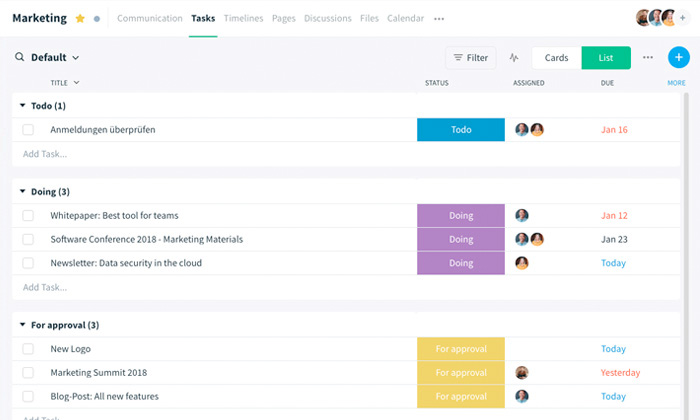
Coordinated tasks
As soon as tasks become more complex and require more than one executor, the demands on the tool increase. Coordinated tasks tend to be of this nature: even if they are not part of a larger process and tend to occur spontaneously, they are carried out together with other team members, who in turn have to coordinate their work. The tasks are therefore more extensive.
Example::
You want to update your product portfolio: a person in charge has to update/expand the text, then a graphic designer has to redesign the new text to make it visually appealing.
What does task management for coordinated tasks look like?
Coordinated tasks often have a larger scope and may involve several responsible parties. To ensure that the task is completed as smoothly as possible, it should always be clear at which point the task is currently located and by whom it is being processed. This can be achieved in various ways.
On the one hand, several subtasks can be added to a task, which in turn can be assigned to different participants and provided with an independent due date. All important information - that is, information relevant to the team - can be recorded in the task description, in comments on the task or with file attachments.
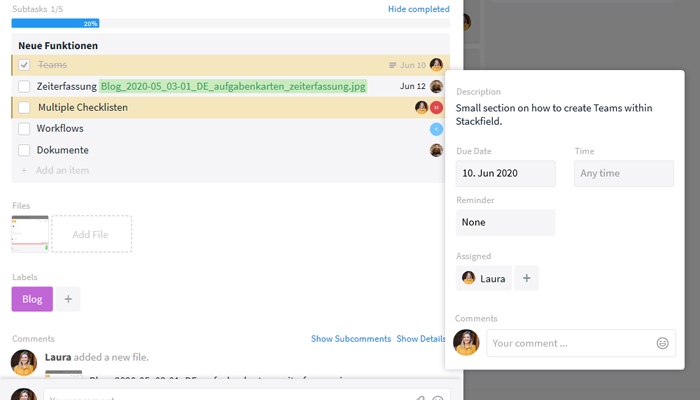
Another helpful feature for task management in the team is the function that allows certain areas of pictures and pages to be marked and commented on directly. Image annotations appear as unclarified annotations in the task until they are marked as clarified.
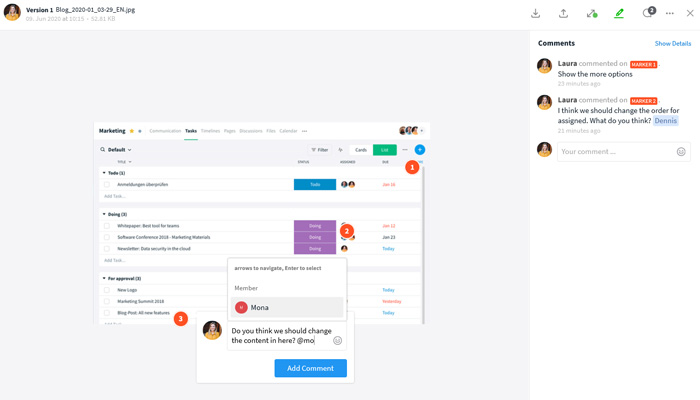
Pre-planned tasks
In project management, task management naturally becomes much more complex than with the types of tasks already mentioned, which tend to occur spontaneously. There is a primary goal to be achieved by completing a large number of pre-planned tasks. Put simply, the tasks are part of a higher-level process and require detailed planning. There are many participants who need to coordinate their tasks with each other and with the project goals. Task management is influenced by a number of higher-level rules and structures and must be mapped accordingly, which is why the demands on task management software are considerably higher.
Example: The company would like to launch a new software on the market. Project managers and developers work together with a variety of stakeholders to complete the project and perform tasks within defined project phases and workflows. Individual functions are planned, checked for feasibility and relevance, developed, tested and released. As we see: It can take a little longer to complete individual tasks.
What does task management for planned tasks look like?
As already mentioned, planned tasks within projects are based on defined processes, which have to be worked out and mapped in the best possible way. Simple task lists and detailed task cards alone are no longer sufficient for this purpose. A comprehensive project management software is required for task management, which visualizes all processes in the best possible way.
Kanban Boards help to keep track of the status of all tasks and increase productivity. The task workflow is displayed as simply as possible for all team members in a construct consisting of different status columns: The goal of each task is to get from the "To Do" column, via various other status columns (e.g. In Progress, Testing, Reopened etc.) to the "Done" column.
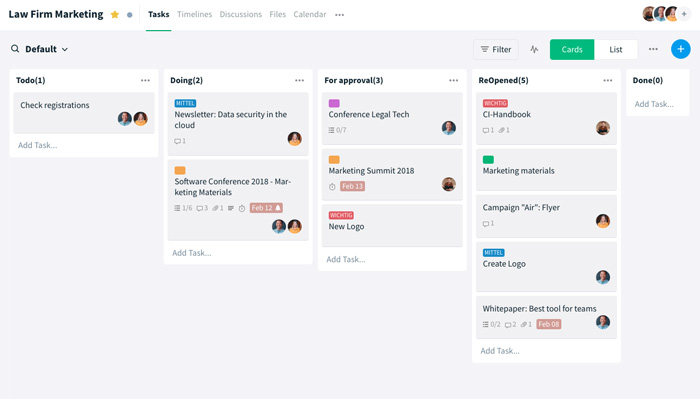
Note: Of course, Kanban Boards in their simplest form can also be used to visualize tasks outside of fixed structural specifications - for example, for coordinated tasks. There are no limits to creativity when designing Kanban Boards. The board can be adapted for different purposes. For example, you can convert it into an editorial plan.
If the completion of individual tasks is often dependent on the completion of other tasks and the project planning in this context has to be kept in mind in terms of time, the use of a Gantt Chart makes sense. Here, all tasks of the project are visualized in a timeline chart and in consideration of their dependency on other tasks. A project manager can see at a glance what impact it will have on the project as soon as the completion of a task takes more time than originally planned
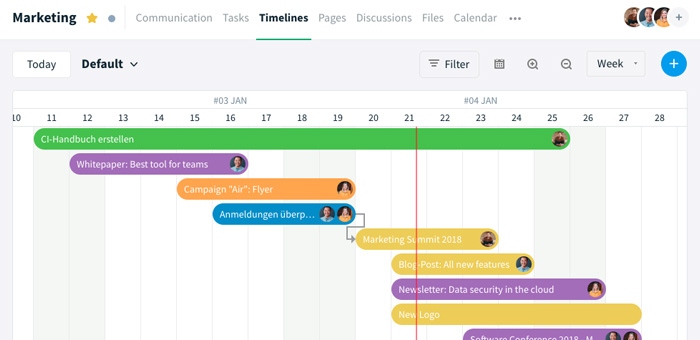
Helpful tools for task management at a glance
Task visualization:
The most important factor for a functioning task management is the appropriate method for visualizing tasks (or a combination of several). Task visualization helps your team to keep track of the status and responsibilities, identify bottlenecks and work as effectively as possible.
- To-do lists are suitable for simple spontaneous tasks that can be completed quickly.
- Kanban Boards help to visualize coordinated and planned tasks. They show your team the current processing status of the tasks at any time.
- Gantt-Charts(timelines) show you where your project is at the moment, in which order tasks have to be processed and whether time adjustments to individual tasks will also have an effect on other effects and the entire project.
Task assignments
… ensure that everyone knows who is responsible for completing individual tasks. Assign each task to a specific person to prevent important tasks from being left behind and overlooked. Finally, the assignment ensures that tasks appear in your own weekly overview, along with relevant notifications and reminders.
Subtasks
… help you to break down tasks into individual work steps so that you don't forget anything important. They also make it easier to work together with other team members.
Due dates
… on tasks are essential to ensure on-time task management. You can set due dates, the exact time, or longer time periods for starting and completing tasks.
Comments
… on tasks keep the exchange in the team topic-specific and easy to understand.
File and document attachments
… to tasks ensure that all necessary information is always directly and centrally available. Comment file-specific and use the annotation function for image files to highlight specific content in the task.
Labels
… serve various purposes in task management. They can provide information about priorities or more detailed processing statuses (for example, "waiting for confirmation") and they can provide a thematic classification of the task (to customers, teams, project phases). Labels can be used to create order within workflows or backlogs and to filter them more easily.
The time recording function
… tracks how long you have worked on a task. This helps you later when planning similar tasks but also for accounting purposes.
Choose the right task management approach for your team and your tasks
Tasks are defined as individual work units that need to be completed. This may sound simple, but task management should not be underestimated. Spontaneous, case-by-case tasks can still be completed without a dedicated approach and relatively quickly and easily. However, complex tasks that are intertwined with other tasks and within a complex project process require a structured task management system and appropriate task management software. The types of tasks to be processed and the tools and methods to be used determine to a large extent how efficiently the task management proceeds.